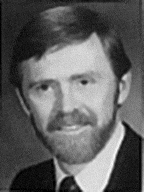


Editorial
Editorial

The cover illustration is a superposition of five members of the short chain dehydrogenase family whose structures have been reported in the past four years. Although the five structures have only twelve amino acid residues in common (the ten conserved nonglycine residues are labeled)they all have the familiar cofactor binding domain that has come to be known as the Rossmann fold. These structures are but one example of the explosion in macromolecular structure determinations that has produced a record number of abstracts for the Seattle Congress.
More than anyone else, the Ewald Prize winner, Michael Rossmann (also on the cover) is responsible for the structural explosion in the macromolecular field, brought on by the molecular replacement method he developed.
The burst of new and exciting structures is not limited to macromolecules as the rich program in materials research, powder, fiber and thin film analysis, organic, inorganic, mineral, organometallic, and amorphous materials amply demonstrates. As the Newsletter goes to press, 2000 abstracts had been received by the secretariat. The titles and first authors of those abstracts have been posted to the web so that members of the Program Committee and Chairs and Co-chairs of the 105 microsymposia can begin to organize the invited, contributed and poster presentations on their respective topics. Although an effort will be made to place the full abstracts on the web, the first priority of the secretariat will be to prepare the abstracts for production of the abstract book to be distributed in Seattle. A special effort will be made to place abstracts submitted in html onto the web early since many contain hot buttons that rely upon electronic access for exploitation. Of the 2000 abstracts 60% were submitted electronically and those are likely to reach the web before the hard copy submissions that must be scanned as well as edited.
I attended the annual meeting of the Biophysical Society in Baltimore, February 18-20. From my somewhat biased perspective, the most exciting presentations were reports of crystal structure determinations, including a mushroom shaped seven fold symmetric membrane active protein structure determined by Eric Gouaux and the astonishing structure of the toxin colicin A1, reported by M. C. Wiener. Not only are the structures aesthetically pleasing, but they eloquently demonstrate the intimate relationship between form and function. The colocin A1 structure has a central domain at one end of the long coiled pair of helices. That domain recognizes a specific protein on the outer membrane of mitochondrial cells and then drops two anchors through the outer membrane. One of these anchors resides in the inner membrane and bores a hole in the membrane to let ions pass.
While at the Biophysical Meeting, I tried to encourage some of the exhibitors to come to Seattle. Several of them said that crystallographers didn't buy their products. I convinced a few of them that today's crystallographer needs more than a diffractometer. Today's crystallographers are biologists, chemists, pharmacologists, database managers, physicists, mineralogists, forensic scientists, and kineticists. They sequence, synthesize, isolate and purify peptides, proteins and nucleic acids. They probe structures with neutrons, X-rays, electrons and microscopes of all types (optical, electron, atomic force) and are major users of synchrotron facilities.
They are looking for better ways to model, examine, illustrate, and analyze structures. They want the best software and graphics capabilities and the most powerful computers from PC's to supercomputers. They want better hardware and software to manage access and use the Protein Database, the Cambridge Structural Database, the Inorganic Database, the Crystal Growth Database, the Powder Diffraction File, etc.
The next time you buy something for your research, let the supplier know you are a crystallographer and send us the suppliers name to add to the Newsletter mailing list. The XVII Congress should be a place where 3,000 crystallographers can come for one stop shopping.
Cover Gate Cover-Up
At the last minute, a picture of the membrane active protein of Gouaux that we had prepared for the cover was withdrawn at the authors request, pending publication. On extremely short notice, the cover illustration had to be substituted.


